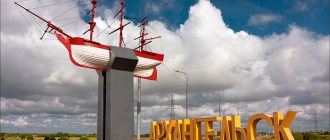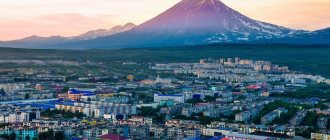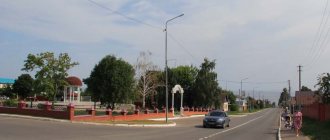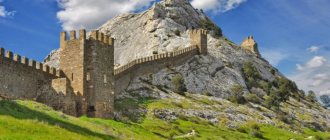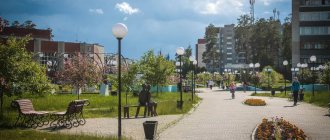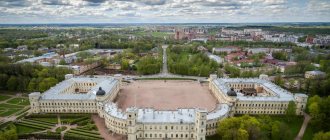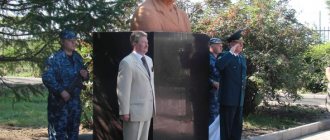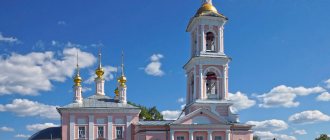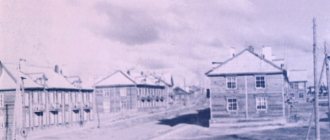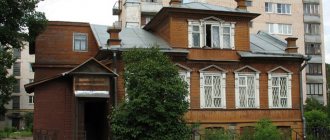Kem is a city of interest primarily because of its beautiful, harsh nature: the White Sea and the Kem skerries, which include the famous Kuzova archipelago. The main attractions of Kemi are the Pomorye Museum and the ancient Assumption and Annunciation Cathedrals.
The city of Kem is known primarily as the closest mainland point to the Solovetsky Islands; it is called the sea gate to Solovki. The port is located 12 kilometers from the city - in the village of Rabocheostrovsk on Popov Island. From here you can get to Solovki by boat or motor ship. Navigation lasts approximately from the end of May to the end of September.
The city itself is small, located on the banks of the Kem River, at its confluence with the White Sea. Urban architecture - old low-rise buildings, mostly wooden.
A few facts about Kemi
- The word “Kem” is translated from the Pomeranian dialect as “Big River”.
- The distance from Kem to Medvezhyegorsk is 260 km, to the capital Petrozavodsk - 410 km, to Murmansk - 560 km.
- Population: approximately 11.2 thousand people.
- Mostly Russians live in Kemi, but there are also indigenous ethnic groups - Karelians and Pomors.
- The climate in the city is cold and temperate, the maximum temperature in July, the warmest month, reaches +18.1 °C.
- Kem was founded in the 14th century and originally belonged to Novgorod, but in the 15th century it was transferred to the Solovetsky Monastery.
- In the 16th century, Kem survived the devastating raids of the Finns and Swedes, who devastated not only it, but also the surrounding lands. At the end of the same century, the local lands were again returned to the Solovetsky Monastery.
- Under Catherine II, Kem became part of the Onega district of the Arkhangelsk province. At the same time, the settlement received city status.
- In the 20s of the last century, a political and criminal concentration camp was organized in Kemi - prisoners awaiting transport to Solovki were kept here. The building of the Solovetsky Camp Administration still stands in the city.
- The famous director Sergei Aleksandrovich Solovyov is from Kemi - he has produced such films as “Assa”, “Black Rose - the Emblem of Sadness, Red Rose - the Emblem of Love”, “Tender Age” and many others.
- An image of the city can be found on the 10-ruble commemorative coin of the “Ancient Cities of Russia” series.
The main attractions of Kursk - TOP-5
The city will delight the inquisitive traveler with numerous cultural and historical monuments. Among the various attractions, it is worth highlighting what you absolutely must see in Kursk, even if you are passing through here.
Triumphal Arch
Address: Pobeda Avenue. Transport stop "Kartodrom".
In 2000, at the entrance to the city from Moscow, a memorial complex dedicated to the victory in the Battle of Kursk, which largely predetermined the outcome of the Second World War, was inaugurated. The dominant feature of the architectural ensemble, which includes the Church of St. George the Victorious and the monument to Marshal of Victory, is the 24-meter Triumphal Arch. The majestic structure is crowned with a sculptural composition depicting St. George piercing a defeated dragon with a spear. Between the columns at the base of the arch there are sculptures of an epic knight and soldiers of the Russian army in uniforms characteristic of different eras of its existence.
Znamensky Cathedral
The majestic building of the cathedral, considered one of the hallmarks of Kursk, is an architectural monument of federal significance. The temple was consecrated in 1826 in honor of the miraculously acquired image of the Mother of God “The Sign”, as well as to commemorate the victory of Russia in the Patriotic War of 1812. The structure in the style of solemn classicism is truly impressive. Its huge dome rises 48 m above the ground, and the main bell weighs 1380 kg. The building shines with columns and gilded openwork onions. The interiors of the cathedral are decorated with delightful paintings, elegant stucco moldings, and stunning stained glass windows. The temple icon is now in the USA, but in the church you can see its exact list. The main relics of the cathedral are considered to be the images of John of Shanghai, Matrona of Moscow, Seraphim of Sarov, containing particles of the relics of saints.
Red Square
Address: Central district. Transport stop "Red Square".
In the 40s of the last century, Red Square was considered the most beautiful in Kursk, but many of its buildings were significantly damaged during the Second World War. Immediately after the end of the war, restoration work began, thanks to which the recreation acquired its modern appearance. Here you can see several magnificent buildings, including the Znamensky Cathedral, the Central Hotel, and the House of Soviets. The decoration of the square is the monuments to V. Lenin and Alexander Nevsky. The ensemble includes the Pervomaisky Park and the Memory Stele, with the names of 270 natives of the city awarded the title of Hero of the Soviet Union.
Building of the Noble Assembly
Address: st. Sonina, 4. Transport stop “Ulitsa Sonina”.
The stunningly beautiful mansion, erected in 1877 for the city Assembly of Nobility, is rightly considered one of the architectural pearls of Kursk. It immediately attracts the eye with its eclectic exterior. The decor of the building's façade clearly shows the features of the lush Baroque and romantic Italian Renaissance. The mansion is decorated with half-columns and openwork pilasters. The cornice above the entrance is crowned by a massive but surprisingly elegant attic.
Stele "City of Military Glory"
Address: Pobeda Avenue. Transport stop "Kartodrom".
In 2007, Kursk was awarded the title of City of Military Glory. To commemorate this event, three years later a monument was solemnly opened here. A Doric column is erected on a quadrangular pedestal in the center of a small square. It is crowned with a gilded double-headed eagle. The pedestal is decorated with cartouches with the coat of arms of Kursk and the text of the presidential decree. The composition is completed by four pylons located in the corners of the square. On them are placed cast-iron slabs with high reliefs telling about the heroism of Kursk residents shown on the fronts of the Second World War and in the rear.
Assumption Cathedral
Assumption Cathedral Kem
Address: Vitsupa street.
The wooden Assumption Cathedral in Kem is a significant landmark of Karelia. It is located in the historical part of the city - on Lepostrov. The temple was built at the beginning of the 18th century in honor of the victory over the Swedes in the Northern War and is surprising in that no nails were used in its construction.
Inside there is an iconostasis, illuminated by windows located near the ceiling. Thanks to this, on sunny days it seems that it glows from within. Previously, the cathedral contained ancient icons painted by craftsmen of the Novgorod school of icon painting, but due to the need for their restoration, they were transferred to the Russian Museum.
Now the temple is under restoration.
Academic Drama Theater named after. V. Savina
This theater is the oldest in the entire Komi Republic. The repertoire of the V. Savin Theater includes not only classical productions, they also show performances based on national plays of Komi, there is a very strong troupe here. The artistic director of the theater, Tatyana Vyrypaeva, was awarded the title of Honored Cultural Worker of Russia, and the troupe includes Honored Artists of the Russian Federation and the Komi Republic: Alexander Tribelgorn, Galina Mikova, Viktor Gradov, Vera Gabova and others.
Examples of productions that can be appreciated here with pleasure: “Hamlet” by W. Shakespeare, “Pannochka” by N. Sadur, “Bloody Fate” by G. Lorca, “A Very Simple Story” by M. Lado. So this place is perfect for a pleasant evening in Syktyvkar.
Address: Pervomaiskaya street - 56.
Regional Museum of Pomorie
Website: pomorie-karelia.ru Address: st. Vitsupa, 12.
The museum is located in the city center, not far from the Assumption Cathedral. The institution was founded almost 40 years ago, and over all the years of its existence it has managed to accumulate approximately 6 thousand exhibits that tell us about the history, culture, traditions and customs of the Northern Pomors.
Several permanent exhibitions are available to visitors, including:
- an exhibition dedicated to the origin and development of Kemi;
- a collection of exhibits on church themes (relics of the Orthodox Church and Old Believers);
- an exhibition on the theme of Pomeranian crafts: fishing, hunting sea animals, salt making and shipbuilding. The main exhibit is a Pomeranian ship;
- exhibitions dedicated to the life and everyday life of the Pomeranians and Kemlyans: “Pomeranian Upper Room” and “Room of the Kemlyan Citizen”;
- exhibition "Merchant's Shop".
Maritime historical and cultural
The Maritime Museum has been successfully operating since 1996 in Petrozavodsk. The center’s employees carry out large-scale and truly important work to preserve unique maritime traditions. Specialists are engaged in recreating drawings for sea voyages on which they go on their own.
The museum displays sailing ships, which are important historical exhibits. It is interesting to note that during the expeditions it was possible to collect significant scientific material reflecting the important features of navigation. As a result of this approach, the exhibition continues to expand, and the museum staff is doing everything possible to preserve maritime traditions.
Location: Petrozavodsk, Rigachina street - 37.
Kem barracks
Kem barracks, located on the outskirts of the city, was once a fairly large military town. The first buildings appeared here back in the 30s, then the town gradually grew and expanded.
Today you can see many buildings here - some are used as residential buildings, others are used as offices of various enterprises and firms. But still the main buildings - the headquarters and two barracks - are in a dilapidated state. At the end of the 60s, the military was transferred from here to the Far East, and until the 90s, motorized rifle units were located here. After they left the town, it stood in desolation.
Abandoned buildings are often where companies gather and people without a fixed place of residence live, so if you look at this attraction, it’s only from afar.
Blagoveshchensky cathedral
Address: st. Lenina, 14
The Annunciation Cathedral is the only stone church in Kemi. The building was erected in 1903 with the money of the Ostashevo merchant Fyodor Antonov and has an absolutely amazing and at the same time tragic fate. The Bolsheviks did not spare the temple, and as a result, in 1934 it was closed and converted into warehouses. The location of the iconostasis located here is still unknown.
The use of the cathedral for other purposes led to disastrous consequences - first the roof collapsed, then the bell tower, and cunning entrepreneurs of the 90s took everything that could be taken out of it. The once beautiful and majestic building was a sad sight - only peeling walls remained. Now the cathedral is being restored.
Annunciation Cathedral before the start of restoration
The Annunciation Cathedral has been reopened since 1991, when it was officially returned to the Russian Orthodox Church, and services and liturgies are held in its basements. At the beginning of the 21st century, a monastery was established here - the Kemsky Annunciation Monastery in the name of the New Martyrs and Confessors of Russia. The monastery is named after the people who passed through the Kem transit. Many of them were clergy - priests, monks.
TOP-5 attractions of Cheboksary
Among the many interesting things that the city will delight its guests with, it is worth highlighting several attractions that are considered the calling cards of Cheboksary. No excursion is complete without visiting them.
Monument to the Patron Mother
Address: Historical embankment. Transport stop "Vvedensky Cathedral".
The main attraction of the capital of Chuvashia rises on a hill, not far from the Historical Embankment. A woman-mother, dressed in national clothes, raising her hands to the sky, seems to bless the inhabitants of the city and protect them from harm. The sculpture is placed on a high pedestal. The total height of the monument is 46 m. It is interesting that at one time heated debate arose among the city clergy regarding the sacred meaning of the monument. Some priests found similarities in the sculpture with a pagan idol.
Victory Park
Address: st. Zoya Yakovleva. Transport stop "Victory Park".
During the war, tens of thousands of sons of the republic went to the front, and their wives and children worked heroically in the rear, bringing the great Victory closer. The memory of the terrible war and the feat of the people who broke the back of fascism is immortalized in the memorial landscape composition of the huge Victory Park in Cheboksary, laid out in a picturesque place on the banks of the Volga. The architectural composition includes the Monument of Glory with the Eternal Flame, monuments to soldiers who died in the Chechen War, Internationalist Soldiers, liquidators of the Chernobyl nuclear power plant accident, the chapel of St. John, Alley of Memory and Glory.
Monument to V.I. Chapaev
Address: Lenin Avenue. Transport stop for "Cosmonaut Nikolaev".
Chuvashia has given Russia many wonderful people who have proven themselves in various fields. The most prominent military leader among them is Cheboksary native V.I. Chapaev. The image of the legendary division commander, who became a folk hero, was wonderfully depicted in his novel by D.A. Furmanov. The monument to Chapaev appeared in the city in 1960 and immediately became an iconic landmark of Cheboksary. Cast in bronze, the sculpture of a dashing cavalryman riding a rearing horse with a saber in his hand is 5 m in height. It is erected on a 10-meter granite pedestal, decorated with bas-reliefs on the theme of the Civil War.
Monument “Unity of Peoples and Cultures”
Address: 500th Anniversary Park Cheboksary. Transport stop "Student Town".
About 97 peoples professing 12 religions and cults live on the territory of Chuvashia. At the same time, there are no conflicts on interethnic grounds here. The monument to the indestructible friendship of peoples, one of the symbols of Cheboksary, can be seen in the park of the 500th anniversary of the city. The sculptural composition, made of bronze, consists of seven figures of girls holding a lotus flower in their raised hands. On each of the seven lower petals of the inflorescence there is a symbol of a certain religion - Muslim, Christian, Buddhist, Hindu, Judaic, Zoroastrian and Chinese yin-yang philosophy.
Merchant Efremov Boulevard
Address: Historical center of Cheboksary. Transport stop "National Congress".
The pedestrian promenade passing through the historical quarters is often called the Cheboksary Arbat. It bears the name of the wealthy merchant and philanthropist P.E. Efremov, who did a lot to ensure that Cheboksary turned into a thriving trade and logistics center of the Volga region at the turn of the 19th and 20th centuries
Walking along the boulevard, tourists will be able to admire the Efremov family mansion, which attracts attention with its eclectic architecture, colorful sculptures, and rock garden. Here is the Beer Museum, exhibition halls of the National and Geological Museums, Chuvash Drama Theater
The boulevard leads to Red Square with its fountains and monuments.
Elephant Office Building
Address: Lenin street, 10.
In the 30s of the 20th century, the Office of the Solovetsky Special Purpose Camps (USLON) was located in this building on the third floor. On the first two floors there was a store, a restaurant, and a hairdresser, serving the administrative staff of the Gulag.
It was here, in the attic, that part of the file index on prisoners of the Solovetsky camp (1927-1929) was found. The cards were wrapped in brown paper and hidden in the sand of the attic floor.
The building is located next to the Annunciation Cathedral; now there are shops here.
Krivoporozhskaya HPP
Address: pos. Crooked Threshold.
Getting to this attraction of Kemi is not difficult - it is located in the village of Krivoy Porog not far from the city. The construction was launched in 1993. Having visited this majestic place, you can see with your own eyes a huge artificial waterfall falling from a 30-meter concrete dam that impedes the river flow.
On the banks of the reservoir there are places specially designed for fishing. And the forests nearby are a real paradise for mushroom pickers. Rumor has it that there are so many mushrooms here that there is enough for all lovers of “quiet hunting” who come here for them until November.
Kemskaya forwarding
Berth in Rabocheostrovsk
Address: pos. Rabocheostrovsk
One of the most terrible pages in the history of the USSR is connected with Kemya - here was the legendary point of transfer of prisoners to the Solovetsky Special Purpose Camp (SLON). A few kilometers from the city on Revolution Island (renamed Popov Island) there was the Kemsky forwarding point or simply the Kemsky forwarding point.
The Kem transfer and distribution point was created in 1920 on the site of empty barracks created by the British during the intervention in 1918. On the island there was also a timber mill, a commercial port and a railway line from the Kem station, built by timber merchants. It was along this branch that the arrested people drove to the stop, and then walked on foot along the embankment road (1.5 kilometers).
The Kem transfer station was a town of wooden barracks, surrounded on all sides by barbed wire. Between the barracks there was a wooden platform, called Nevsky Prospekt by the prisoners.
Kemskaya forwarding, Nevsky Prospekt
Not all prisoners were transferred to Solovki; some of them remained on the mainland and worked in logging, construction of roads and settlements. During the cold season, when navigation to Solovki was not carried out, a huge number of prisoners accumulated at the Kem crossing.
The Solovetsky Special Purpose Camp (SLON) was closed in 1939. The Kemskaya forwarding buildings were transferred to the Timber Plant. Now almost nothing remains of them: somewhere there are remains of foundations and piles for buildings, somewhere there are remains of concrete structures. Several buildings are used for housing.
It is noteworthy that there is no monument here in memory of the numerous victims of political repression. But everything connected with the Gulag system and its victims should never be forgotten.
Economics and transport
The city of Kem is the economic center of the Kem region. The city has enterprises in the fields of tourism, trade, services, agriculture, transport, hydropower, and there are enterprises in the mining industry. The largest enterprises include:
- Cascade of Kem hydroelectric power stations;
- Fish hatchery;
- Bakery;
- Industrial plant;
- Printing house.
There are plans for the further development and reconstruction of the Kem seaport within the framework of the federal program.
The St. Petersburg – Murmansk railway line passes through the city of Kem. There is a water connection with Solovki (many tourists come from here).
Filming location for "The Island"
Scenery for the film Island, Rabocheostrovsk
In the village of Rabocheostrovsk in 2005, the filming of Pavel Lungin’s drama “The Island” took place. Interesting fact: the temple located here was built specifically as a set for the film.
The buildings for the “Island” have become a landmark of Rabocheostrovsk, but are gradually being destroyed.
Archipelago Kuzova
Quite a lot is known about this attraction of Kemi - there are monuments of the ancient culture of the indigenous Sami people here. Tourists can see here their sites and religious buildings of the Mesolithic era - sacred stones, or seids. The Kuzova archipelago consists of 16 islands, on which a large number of historical and natural monuments are located. The largest of them are the Russian and German islands.
There are 200 Sami stone idols on the German island of the archipelago. According to legend, they protected local residents from the encroachments of the Germans - they created storms and storms, and turned the invaders into stone. This legend gave the name to the German Island.
The islands of the Kuzovetsky archipelago have the official status of a state reserve, so great restrictions are imposed on the stay of tourists here. By the way, this is what made it possible to preserve the pristine beauty of these places.
Dense spruce forests, huge boulders covered with northern lichens, clean air, untouched shores of reservoirs - this is all that makes it worth coming here. And if you are very lucky, you can see a sea hare, beluga whale or ringed seal here. You can get to the Kuzovetsky archipelago from Kemi by boat.
